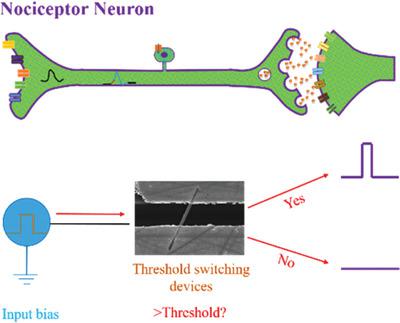当前位置:
X-MOL 学术
›
Adv. Electron. Mater.
›
论文详情
Our official English website, www.x-mol.net, welcomes your feedback! (Note: you will need to create a separate account there.)
Threshold Switching in Single Metal‐Oxide Nanobelt Devices Emulating an Artificial Nociceptor
Advanced Electronic Materials ( IF 6.2 ) Pub Date : 2019-11-13 , DOI: 10.1002/aelm.201900595 Ming Xiao 1, 2, 3 , Daozhi Shen 3, 4, 5 , Moritz H. Futscher 6 , Bruno Ehrler 6 , Kevin P. Musselman 1, 2 , Walter W. Duley 3, 7 , Y. Norman Zhou 1, 2, 3
Advanced Electronic Materials ( IF 6.2 ) Pub Date : 2019-11-13 , DOI: 10.1002/aelm.201900595 Ming Xiao 1, 2, 3 , Daozhi Shen 3, 4, 5 , Moritz H. Futscher 6 , Bruno Ehrler 6 , Kevin P. Musselman 1, 2 , Walter W. Duley 3, 7 , Y. Norman Zhou 1, 2, 3
Affiliation

|
Electronic devices that can simulate the dynamics of neurotransmission in the human body are of great interest for the development of artificial intelligence in modern information technology. An artificial nociceptor realized by a single metal‐oxide nanobelt device with a unique capacitive‐coupled threshold switching behavior is demonstrated. Via thermal admittance spectroscopy and temperature‐dependent sweeping study, the properties of the nanobelt devices are determined by Schottky emission at low bias and by defect‐assisted quantum tunneling at high bias subject to a threshold voltage. The low activation energy associated with dynamic electron trapping gives rise to a voltage‐dependent volatile threshold switching behavior. This threshold switching behavior allows the emulation of several characteristic features of a nociceptor, a critical type of sensory neuron in the human body, including “threshold,” “relaxation,” “no adaptation,” “allodynia,” and “hyperalgesia” behaviors, essential for the realization of electronic sensory receptors that detect noxious stimuli and signal rapid warning to the central nervous system. One‐dimensional metal oxide nanobelt devices of this type yield multifunctional nociceptor performance that is fundamental for applications in artificial intelligence systems, representing a key step in the realization of neural integrated devices via a bottom‐up approach.
中文翻译:

单金属氧化物纳米带装置中模拟人工伤害感受器的阈值切换
可以模拟人体中神经传递动力学的电子设备对于现代信息技术中人工智能的发展引起了极大的兴趣。演示了一种由单金属氧化物纳米带器件实现的人工伤害感受器,该器件具有独特的电容耦合阈值开关行为。通过热导率光谱法和依赖温度的扫描研究,纳米带器件的性能由低偏压下的肖特基发射和受阈值电压作用的高偏压下的缺陷辅助量子隧穿决定。与动态电子俘获相关的低活化能会引起电压相关的挥发性阈值开关行为。这种阈值切换行为可以模拟伤害感受器的几个特征,人体中一种重要的感觉神经元类型,包括“阈值”,“放松”,“无适应”,“异常性疼痛”和“痛觉过敏”行为,这对于实现检测有害刺激并迅速发出信号的电子感觉受体至关重要警告中枢神经系统。这种类型的一维金属氧化物纳米带设备可产生多功能伤害感受器性能,这对于人工智能系统中的应用至关重要,代表着通过自下而上的方法实现神经集成设备的关键一步。
更新日期:2020-01-13
中文翻译:

单金属氧化物纳米带装置中模拟人工伤害感受器的阈值切换
可以模拟人体中神经传递动力学的电子设备对于现代信息技术中人工智能的发展引起了极大的兴趣。演示了一种由单金属氧化物纳米带器件实现的人工伤害感受器,该器件具有独特的电容耦合阈值开关行为。通过热导率光谱法和依赖温度的扫描研究,纳米带器件的性能由低偏压下的肖特基发射和受阈值电压作用的高偏压下的缺陷辅助量子隧穿决定。与动态电子俘获相关的低活化能会引起电压相关的挥发性阈值开关行为。这种阈值切换行为可以模拟伤害感受器的几个特征,人体中一种重要的感觉神经元类型,包括“阈值”,“放松”,“无适应”,“异常性疼痛”和“痛觉过敏”行为,这对于实现检测有害刺激并迅速发出信号的电子感觉受体至关重要警告中枢神经系统。这种类型的一维金属氧化物纳米带设备可产生多功能伤害感受器性能,这对于人工智能系统中的应用至关重要,代表着通过自下而上的方法实现神经集成设备的关键一步。


























 京公网安备 11010802027423号
京公网安备 11010802027423号